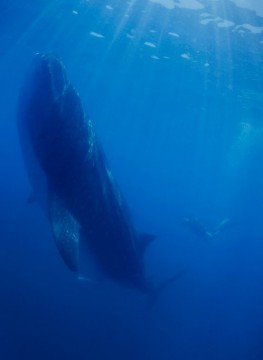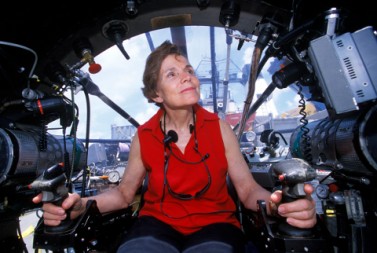I’d like to switch places with Kip Evans for a few months. He’s a professional photographer, underwater explorer, and award-winning cinematographer from Pacific Grove, California and we are delighted to be featuring on QUEST an excerpt of his short film, “Isla Holbox: Whale Shark Island.”
The film is about an unusually large population of whale sharks that gathers off the coast of Mexico’s Holbox Island during the summer months to feed and mate. Narrated by marine biologist, Sylvia Earle, the film explores how the recent discovery of this population of whale sharks – the largest fish in the world- is shifting the economic focus of the surrounding area from fishing to eco-tourism. The film highlights the successes as well as the ecological concerns that have arisen from this transition.

If I was actually able to switch places with Kip Evans, I’m not sure how he would feel about working at KQED and running the QUEST TV series. I’ll admit, my job is pretty much as cool as it gets for a Bay Area science geek and TV producer like me, but Evans's resume makes the day-to-day aspects of my job look downright mundane.
He’s an internationally known photographer who’s been widely published in books and magazines including National Geographic, Outside, Sea and Patagonia. He’s an underwater cinematographer and documentary producer who’s worked on shows for BBC, CNN, Discovery Channel and National Geographic. He’s also the Director of Photography and Expeditions for the Sylvia Earle Alliance and has served for many years as the great marine biologist’s chief photographer and videographer.
I first became aware of Kip Evans's work in 2008 when I produced a QUEST TV story about Sylvia Earle. We only had about two hours to shoot an interview with Earle and that was all the time she could give us for the whole story. We normally shoot with the main subjects of our stories for two or three days in order to get enough footage to make a 10-minute story. So, because I had only a sit-down interview with Earle, I had to acquire all of the footage and photographs of her throughout her career. We were happy to locate Kip Evans and licensed some spectacular underwater footage and photographs from him.

So, when I was thinking about who we could feature in our new segment, “Your Videos on QUEST,” where we feature the work Bay Area filmmakers who tell science, environment and nature stories, I immediately thought of Evans. I feel lucky that he answered the phone when I first called because it seems that he’s often traveling around the world to shoot photographs and video about what he and Sylvia Earle call “Hope Spots”- places that are critically in need of protection and conservation because they are vital to saving what’s left of the planet’s oceans.